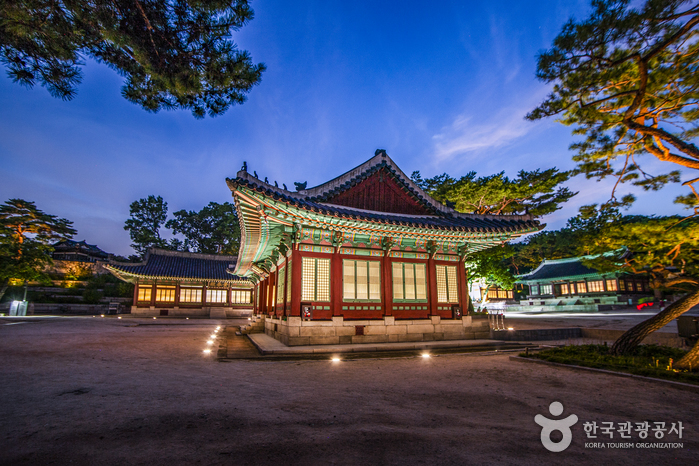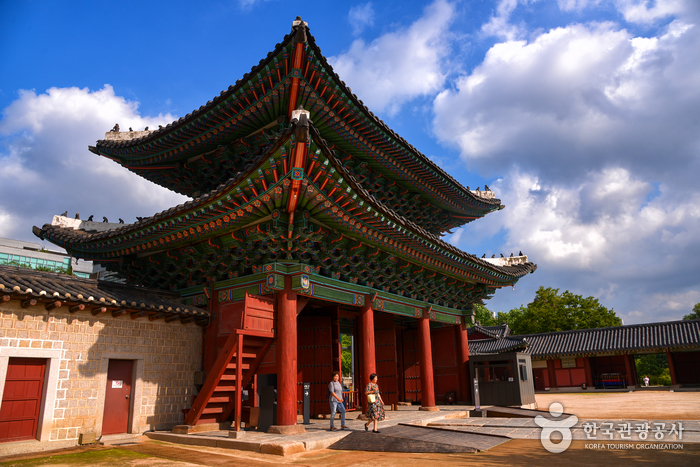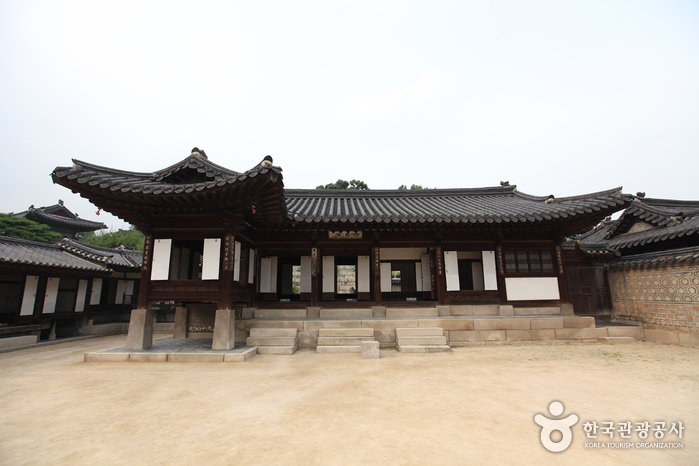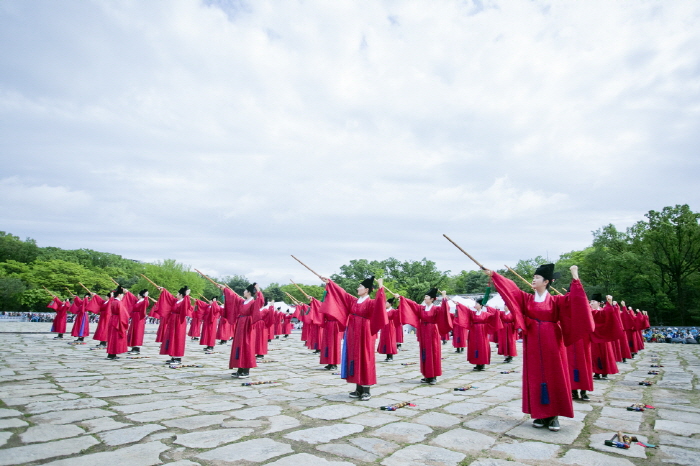Changgyeonggung Palace (창경궁)
13.6Km 2024-10-31
185 Changgyeonggung-ro, Jongno-gu, Seoul
+82-2-762-4868
Located in the heart of Seoul, Changgyeonggung Palace was originally built as Suganggung Palace by the 4th ruler of the Joseon dynasty, King Sejong (r.1418-1450), for his retiring father, King Taejong. It often served as residential quarters for queens and concubines. During the reign of King Seongjong (r.1469-1494), the palace was renovated and renamed to Changgyeonggung Palace. It later became a park with a zoo and a botanical garden during Japanese colonial rule. The palace grounds remained this way until 1983 when restoration of its old grace was completed.
Changgyeonggung Palace Honghwamun Gate (창경궁 홍화문)
13.6Km 2021-05-27
99, Yulgok-ro, Jongno-gu, Seoul
+82-2-762-4868
Honghwamun Gate is the main gate of Changgyeonggung Palace. It has three opening gates in the front and two to the side with a sophisticated locking mechanism.
Bando Camera - Gangnam Branch [Tax Refund Shop] (반도카메라 강남)
13.6Km 2024-04-18
1F, 2F, 3F, 4F, 7F, 445, Yeoksam-ro, Gangnam-gu, Seoul
-
Bukjeong Village (북정마을)
13.6Km 2024-02-15
132-3 Seongbuk-ro 23-gil, Seongbuk-gu, Seoul
Bukjeong Village, situated along the slopes of Seongbuk-dong, offers a glimpse into Korea's old alleyways. The village expanded as refugees from the Korean War (1950–1953) and people from various regions settled, building houses under the collapsed walls of Hanyang doseong (Seoul City Wall). Presently, the village is home to young artists, and the broad street in front of the village bus stop hosts various community events.
Nakseonjae Hall (낙선재)
13.6Km 2021-09-30
99, Yulgok-ro, Jongno-gu, Seoul
+82-2-2148-1822
Located inside Changdeokgung Palace, Nakseonjae Hall is a one-story structure built in ikgong style (bird wing-shaped eaves placed on top of the pillars) with a hip tiled and gable roof. It has 6 kan in the front and 2 kan (traditional unit of measurement of the space between pillars) to the sides. It originally belonged to the nearby Changgyeonggung Palace, but came to be considered a part of Changdeokgung Palace in more recent years.
The hall was constructed in 1846 (12th year of King Heonjong’s reign) and it is collectively called Nakseonjae together with the adjacent Seokbokheon Hall and Sugangjae Hall.
Behind the building is a flower garden made of stacked large stones. The chimney, the flowers, and the oddly shaped stones harmoniously blend into one another to create an outstanding landscape gardening.
Isshou (잇쇼우)
13.6Km 2024-02-15
109 Daelim Acrotel, 524 Seolleung-ro, Gangnam-gu, Seoul
Isshou is a Japanese restaurant specializing in sanuki udon, strategically situated around Seolleung and Jeongneung Royal Tomb, the UNESCO World Heritage. The standout offering is the Isshou jeongsik (pork cutlet with rice and udon set menu), featuring handcrafted udon, deep-fried pumpkin, and a stir-fried beef with rice. The restaurant includes a section where fresh noodles are made, allowing customers to purchase them on the spot. Conveniently located, nearby attractions encompass COEX, Bongeunsa Temple, and the Seoul Arts Center.
Seolleung and Jeongneung Royal Tombs [UNESCO World Heritage] (서울 선릉과정릉) [유네스코 세계유산]
13.6Km 2024-07-05
1 Seolleung-ro 100-gil, Gangnam-gu, Seoul
+82-2-568-1291
Seolleung and Jeongneung Royal Tombs are located near COEX in Gangnam. It comprises two tombs: Seolleung Royal Tomb, which houses the remains of King Seongjong (1457-1495, r. 1470-1495) and his wife Queen Jeonghyeon (1462-1530) of the Joseon dynasty (1392-1897), and Jeongneung Royal Tomb, which houses King Jungjong (1488-1544, r. 1506-1544), Seongjong’s son. The Seolleung and Jeongneung Royal Tombs History Center details the historical significance of the tomb, while the complex also serves as a park within the city.
Seoul Hiking Tourism Center - Bukhansan Branch (서울도심등산관광센터(북한산))
13.6Km 2024-03-05
5F, 181-7 Ui-dong, Gangbuk-gu, Seoul
+82-1533-2608
The Seoul Hiking Tourism Center is located 5 minutes on foot from Exit 2 of Bukhansan Ui Station and provides various services to hikers. It provides hiking course guidance and information (available in Korean, English, Chinese, and Japanese) about the mountains of Seoul, including Bukhansan, Bugaksan, and Inwangsan Mountains, as well as promotional materials such as Seoul hiking tourism guidebooks and maps. Also, it operates hiking tour programs with various themes every week for foreigners and offers hiking gear rental services such as hiking boots, hiking attire, trekking poles, gloves, and crampons for foreigners. (Koreans accompanied by foreigners can also rent the gear.) In addition, there is a storage locker and lounge for visitors, so they can pack up and rest before hiking.
Jongmyodaeje (Royal Ancestral Memorial Rite of Joseon) (종묘대제)
13.6Km 2022-10-05
157, Jong-ro, Jongno-gu, Seoul
• 1330 Travel Hotline: +82-2-1330 (Korean, English, Japanese, Chinese) • For more info: +82-2-3210-4806, +82-2-6011-1067
Jongmyodaeje, Korea’s Royal Ancestral Memorial Rite, is a traditional ritual that has been recognized with many important designations. It is a UNESCO Masterpiece of the Oral and Intangible Heritage of Humanity, Important Intangible Cultural Property No. 56 (Jongmyo Jerye), and Korea’s Important Intangible Cultural Property No. 1 (Jongmyo Jeryeak). The ritual is held yearly on the first Sunday of May. It begins with eogahaengnyeol, the fabulous royal parade dating from the Joseon dynasy, which is truly a sight to behold as it moves through the modern city.
Jongmyodaeje originated as a royal ancestral ritual to honor the past kings and queens of the Joseon dynasty. During the Joseon era, the ritual was held five times a year (spring, summer, autumn, winter, and December) until it was abolished by Japanese colonial rule. In 1969, Jongmyodaeje was reinstated and has been held in May every year since.
Jongmyo Shrine, the destination of the procession, was the setting of ceremonial rituals during the Joseon dynasty. Originally, Jongmyo only referred to Jeongjeon (Main Hall) where the memorial tablets of Joseon’s reigning kings and queens are enshrined. Today, however, Jongmyo also encompasses Yeongnyeongjeon (Hall of Eternal Peace) where the tablets of posthumous kings and queens are enshrined and Gongsindang (Hall of Meritorious Subjects) where the tablets of esteemed ministers of the state are kept.
Iwant Plastic Surgery Clinic [Tax Refund Shop] (아이원성형외과)
13.7Km 2024-04-23
4F, 823, Nonhyeon-ro, Gangnam-gu, Seoul
-


![Bando Camera - Gangnam Branch [Tax Refund Shop] (반도카메라 강남)](http://tong.visitkorea.or.kr/cms/resource/39/2888739_image2_1.jpg)



![Iwant Plastic Surgery Clinic [Tax Refund Shop] (아이원성형외과)](http://tong.visitkorea.or.kr/cms/resource/03/2879703_image2_1.jpg)
 English
English
 한국어
한국어 日本語
日本語 中文(简体)
中文(简体) Deutsch
Deutsch Français
Français Español
Español Русский
Русский